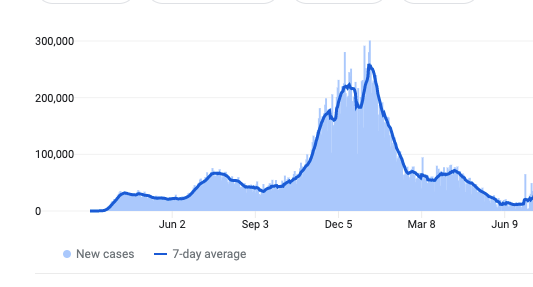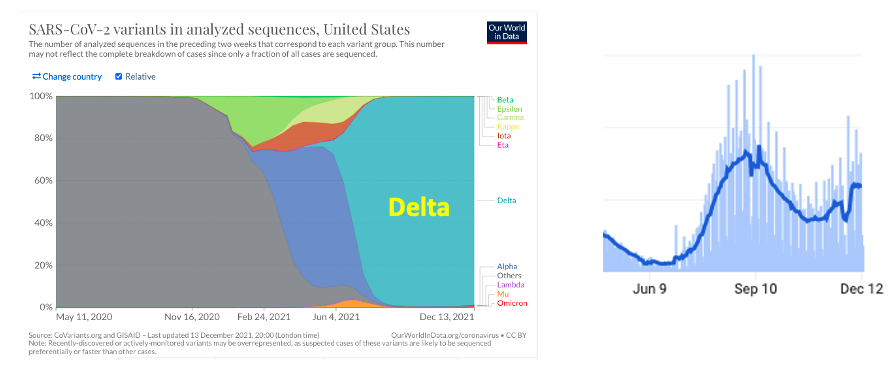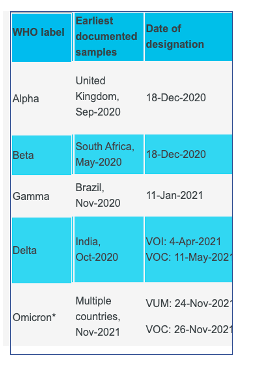If you've been closely following the pandemic from the beginning (I hope you're enjoying the Prozac), it should be obvious how little we really knew about COVID a year ago. Social distancing? Did it really work? Maybe. Was take-out food safe? Who knew? We ran out of hand sanitizer, Lysol wipes, and gloves, only to discover that we probably didn't need them; the virus was transmitted almost exclusively by air. Year #1 was awful by any measure. But we got a much-needed break in late 2020 with the release of the astounding efficacy data of the Pfizer and Moderna mRNA vaccines. Finally, we could relax.
Life was good. Effective vaccines were going into arms, both case numbers and deaths were plummeting, and most of us threw away the masks, went to the movies, and dared to eat inside restaurants. By early June, the number of daily cases was about 12,000, down from a high of 300,000 in January. This thing was beaten. (Figure 1).

Figure 1. COVID going away. Or so we thought. Sources: The New York Times and Our World in Data
But the virus had other ideas. Within a short period of time, a number of mutated variants began to emerge, culminating in delta, the fourth (and worst) Variant of Concern (VOC) (1). By autumn delta was running rampant all over the world. This new variant had a different set of properties that enabled it to spread like wildfire. For example, less than two months after it hit the US (Figure 2), delta would be responsible for more than 92% of cases here; that number was 100% by early September. Driven by delta, which is estimated to be 60% more contagious than the original Wuhan strain, the number of daily cases in the US soared back to about 200,000 by early September. The "COVID holiday" was over. Perhaps more troubling was evidence that delta can partially evade vaccine immunity, calling into question the efficacy of the two mRNA vaccines. We began to hear the term "breakthrough infection" regularly.
Figure 2 (Left) Delta displaced all of the circulating variants in the US in about two months. (Right) The number of daily cases rose accordingly. Source: Our World in Data
Although the vaccines continued to do a fine job reducing hospitalization, severe disease, and death, they were not entirely able to keep pace with viral mutation – something that the designers of the vaccines could not have foreseen (see 'Don't Shoot The Messenger RNA: Blame The Virus, Not The Vaccine'). Between mutation-mediated immune escape and the waning of protection with time, it is not at all surprising that by late September, the FDA authorized booster shots (Pfizer and Moderna only) for people 65 and older, and those with medical conditions that would put them at elevated risk. Before long, boosters were approved for younger and younger people. Now the CDC recommends the shots for everyone 16 and older.
It's not even clear that these third shots should still be called "boosters." Although Dr. Anthony Fauci still maintains that "full vaccination" means two shots, he acknowledges that this is "for now" and that it is inevitable that complete vaccination will soon mean three shots. Semantics. There is no such thing as a booster anymore, just a third shot. Not surprisingly, there is now talk of a fourth shot, although this is not being implemented at the present time.
Apparently not content with the damage caused by delta, the virus recently pulled off another microbiological trick – the omicron variant, which is even more contagious than delta. Omicron was recently detected in multiple locations and was designated as the WHO's fifth variant of concern on November 26th. Although omicron is thought to result in milder disease than its predecessor, it is already responsible for 40% of COVID cases in London. This is mind-boggling given that the first two omicron cases in the UK were identified on November 27th – a bit more than two weeks ago, and the number of cases is doubling every 2-3 days.
New findings from Japan may explain the speed of the London surge. At a meeting of the Japanese health ministry advisory board, Kyoto University Professor Hiroshi Nishiura reported that omicron was 4.2-times more infective than delta, based on mathematical models. Perhaps worse, Takaji Wakita, the head of the National Institute of Infectious Diseases, who led the advisory board:
"The omicron variant may have [a] certain ability to sneak through the immune system... "We need to get prepared for a domestic omicron outbreak."
Dr. Takaji Wakita, December 8, 2021
The potential ability of omicron to evade immune responses was reinforced by a group from Oxford University which published a non-peer-reviewed, pre-print paper on the MedRxiv website. The article noted that two shots of either the Pfizer and Astra-Zeneca vaccines were less effective at preventing infection by omicron than any of the previous variants:
"There was a substantial fall in neutralisation titres in recipients of both AZD1222 and BNT16b2 primary courses, with evidence of some recipients failing to neutralise at all. This will likely lead to increased breakthrough infections in previously infected or double vaccinated individuals, which could drive a further wave of infection, although there is currently no evidence of increased potential to cause severe disease, hospitalization or death."
Screaton, et.al., MedRxiv, https://doi.org/10.1101/2021.12.10.21267534
The authors cautioned; "those who are offered booster vaccination should take it.”
Now What?
There are now some disturbing similarities to the winter of 2020 including:
- Increased mask use, and in some places, reinstatement of mask mandates
- Superspreader events
- Weddings, parties, get-togethers, etc. being canceled.
- School closings (e.g); Cornell University recently announced that it was shutting down its Ithaca, NY campus because of more than 900 confirmed cases, many from the omicron variant. But the following is more disturbing [emphasis added]:
"Virtually every case of the Omicron variant to date has been found in fully vaccinated students, a portion of whom had also received a booster shot."
Joel Malina, Vice President for University Relations
- Impact of sporting events. According to the Wall Street Journal:
- The NBA is already being affected even though omicron is not yet rampant in the US. 97% of the NBA players are vaccinated, and 60% have had boosters. Yet, this week two Chicago Bulls games have been postponed because the league requires teams to play if they have eight healthy players, and 10 of the 15 team members of the Bulls are now sidelined because of the league's safety protocols.
- The NFL, where 94% of the players are vaccinated, has 37 who have tested positive as of yesterday. Expect this number to rise quickly.
- The Calgary Flames are the third NHL team to have their seasons "paused."
- Soccer matches are being canceled in Britain; some teams are playing in empty stadiums in Germany.
American Pi?
None of the Variants of Concern (or those of no concern) could have been predicted in advance. Given two years of non-stop, worldwide research, we know disturbingly little about the behavior of this virus. But one thing is assured: there will be more variants, probably sooner rather than later. If you're not convinced, see Figure 3 below. There have already been five VOCs (plus others that did not make the list) in less than a year.
The next one will be assigned the Greek letter pi. Since the American press has been rather careless in attributing the names of previous variants to other countries that just happened to isolate or discover them, perhaps we'll get a taste of our own medicine. Should pi will emerge (or first be detected) in the US – something that has already happened (3) – I'm guessing that the term "American Pi" will pop up in a headline somewhere and we'll be stuck with it. It's only fair.

Figure 3. Timeline of Variants of Concern. Five in less than a year. Original diagram: WHO
What's Next?
Although there are some disturbing similarities to Winter 2020, there are also significant differences. Despite the emergence of variants capable of infecting fully vaccinated people – even those who have been triply vaccinated, vaccines still do an excellent job of keeping you out of the hospital or morgue. And unless something goes mighty wrong, Pfizer's Paxlovid should be available soon. Then, the game should change and COVID will become a nuisance rather than a nightmare. But, as was the case early on with the vaccines, supply will be a problem. The drug is not easy to synthesize. A process chemist (who wants to remain anonymous) recently told me, "the scale-up is going to be a bitch." This is why Pfizer's initial plan to ship 80 million doses has been scaled back to 50 million. (2)
The Winter of 2021
The winter of 2021 will be difficult, maybe even awful. As I mentioned above, plans and activities, family gatherings, sporting events, education, probably travel, etc., will be victims of omicron. The disturbing number of cases at Cornell guarantees that there will be difficult issues in schools; it is difficult to imagine another year of online "learning" but also difficult to imagine that in-class education can smoothly continue once any thousands of students and teachers become infected. And I am greatly concerned about the collective mental health of people who are still traumatized from lockdowns, isolation, and illness, and deaths of family members from last winter. And omicron is just getting going in the US. Check back in two weeks.
Although the situation is by any measure better than it was a year ago, there are troubling signs that cannot be ignored. Let's hope by the time pi arrives, we'll have the tools necessary to knock it down, if only by 3.14-times.
# Conflict of interest statement. My IRA contains both Pfizer and Merck stock.
NOTES:
(1) New variants begin as "Variants of Interest." Those deemed serious enough to represent a significant public health problem are then "upgraded" to VOCs.
(2) In order to address supply issues Pfizer is investing $1 billion to increase Paxlovid capacity even though the drug has not received EUA.
(3) See the CDC publication "Rapid Emergence and Epidemiologic Characteristics of the SARS-CoV-2 B.1.526 Variant — New York City, New York, January 1–April 5, 2021"




